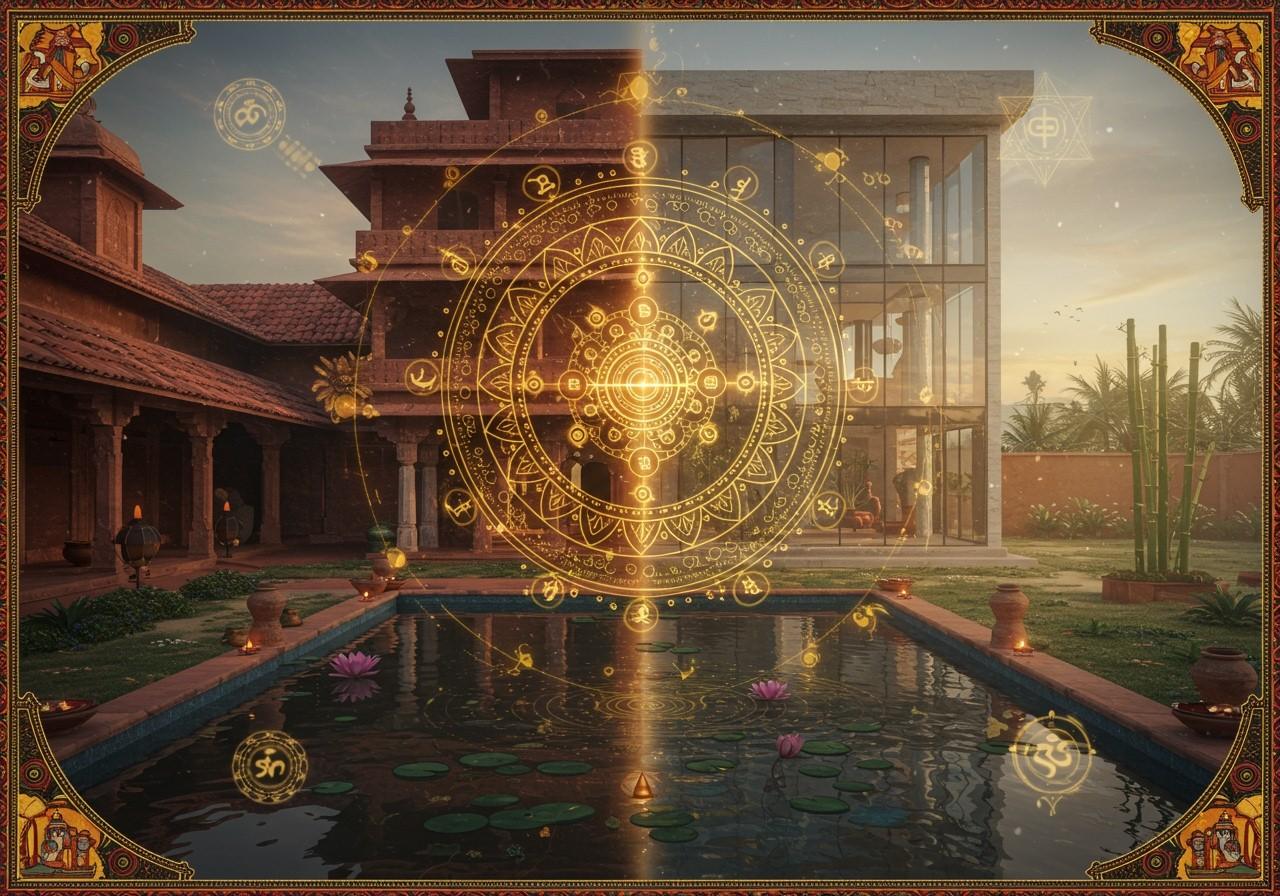
Introduction
Vastu Shastra, an ancient Indian science of architecture and construction, harmonizes human existence with the natural environment. As described in ancient Vedic texts, Vastu Shastra focuses on creating harmonious living spaces by integrating cosmic energy and philosophical principles. It influences the design and construction of various structures, including temples, and emphasizes the importance of positive energy in daily life. This blog explores how Vastu Shastra principles are interpreted across different cultures and languages, focusing on Hindi, English, and Marathi. Understanding these variations offers valuable insights into the cultural influences on this timeless practice, deeply rooted in Indian culture and evolved through the merging of different cultural influences, contributing to a unique cultural identity.
Vastu Shastra in Hindi
Exploring Traditional Vastu Texts in Hindi
Hindi, widely spoken in India, plays a significant role in disseminating Vastu Shastra principles. Traditional Vastu texts translated into Hindi often retain original Sanskrit terminology, bridging the gap between ancient wisdom and modern understanding. Regional customs and rituals in Hindi-speaking areas further influence these translations, adding a layer of cultural nuance.
Popular Hindi Vastu Guides
- Numerous books and publications in Hindi cater to a wide audience, educating them about Vastu principles and their practical applications in daily life. These resources often incorporate local examples and case studies, making them relatable to Hindi speakers.
- Television shows and online platforms have become significant mediums for spreading Vastu knowledge in Hindi. These programs reach a vast audience, offering practical tips and expert advice on incorporating Vastu principles into homes and workplaces.
Role of Hindi in Vastu Consultations
Using Hindi in consultations helps clients understand and engage better with Vastu principles. The ability to communicate in one’s native language fosters a deeper connection with the subject matter, enabling clients to implement Vastu guidelines effectively. Ancient manuscripts and modern publications in Hindi hold cultural significance, serving as valuable resources for both practitioners and enthusiasts.
Vastu Shastra in English
Translation Challenges
Translating traditional Vastu texts from Sanskrit to English can be challenging due to nuances in language and cultural context. However, English helps internationalize Vastu principles, making them accessible to a global audience. This cross-cultural exchange allows for a wider understanding and appreciation of Vastu Shastra.
Adaptation in English-speaking Countries
Vastu principles are adapted to suit local environments in English-speaking countries. This adaptation considers factors such as climate, geography, and cultural preferences, ensuring that Vastu remains relevant and practical in diverse settings. English publications, online courses, and workshops promote Vastu globally, fostering a growing international community of practitioners and enthusiasts.
Influence of Western Architecture
Western architecture and design influence Vastu practices when interpreted in English. This fusion of architectural styles creates a unique blend of Eastern and Western design principles. English-speaking consultants cater to diverse clients, including expatriates and non-Indians, bridging cultural gaps and promoting cross-cultural understanding.
English-language Vastu Resources
- Books, websites, and mobile apps in English help spread Vastu knowledge, making it accessible to a global audience. These resources cater to different learning styles and preferences, offering a variety of ways to engage with Vastu principles.
- English-language media shapes public perception of Vastu Shastra, influencing how it is understood and practiced in English-speaking countries. This media representation plays a crucial role in promoting Vastu to a wider audience.
Vastu Shastra in Marathi
Integration into Marathi Culture
Marathi, predominantly spoken in Maharashtra, offers a unique perspective on Vastu Shastra. Regional architectural styles and construction practices integrate Vastu principles seamlessly, reflecting the cultural significance of this ancient science in the region.
Translation of Vastu Texts into Marathi
Translating Vastu texts into Marathi retains cultural nuances, ensuring that the essence of the principles is preserved. Local publications educate the populace about Vastu principles, making them accessible to Marathi speakers of all backgrounds.
Role of Marathi Media
- Marathi television shows and online platforms spread Vastu knowledge, reaching a wide audience within the Marathi-speaking community. These platforms provide practical tips and expert advice, making Vastu accessible and relatable to everyday life.
- Marathi-speaking consultants impact regional practices and client engagement, ensuring that Vastu principles are applied in a culturally sensitive and effective manner. Their expertise helps clients understand and implement Vastu guidelines in their homes and workplaces.
Marathi Customs and Rituals
Vastu Shastra applications incorporate Marathi customs and rituals, creating a unique blend of tradition and science. Festivals and everyday life reflect the cultural significance of Vastu principles, demonstrating their deep integration into the Marathi cultural fabric.
Cultural Influences on Vastu Shastra
Regional Traditions and Guidelines
Different cultural backgrounds influence the interpretation and application of Vastu Shastra principles. The interplay between regional traditions and Vastu guidelines is evident in Hindi, English, and Marathi-speaking regions, showcasing the adaptability of this ancient science.
Rituals and Beliefs
Cultural rituals and beliefs shape Vastu practices, including the placement of religious symbols and artifacts. Local environmental factors such as climate and geography impact Vastu applications, demonstrating its sensitivity to the natural world.
Architectural Styles
Variations in architectural styles and construction techniques across different cultures influence Vastu practices, creating a diverse range of applications. Social norms and values affect Vastu consultations and client preferences, ensuring that Vastu remains relevant and respectful of cultural sensitivities.
Modern Technology Integration
Modern technology, like software and mobile apps, blends with traditional Vastu practices in different cultural contexts. This integration makes Vastu more accessible and user-friendly in the digital age. Cultural diversity enriches the practice and understanding of Vastu Shastra, contributing to its ongoing evolution and relevance.
Vastu Shastra in Modern Times
Contemporary Relevance
Vastu Shastra remains relevant in contemporary architecture and interior design. Integrating Vastu guidelines with modern construction techniques presents challenges and opportunities, fostering innovation and creativity in the field.
Technology’s Role
Technology facilitates Vastu consultations and implementations through software and mobile apps. Online consultations make Vastu accessible to a global audience, expanding its reach and impact.
Impact of Urbanization
Urbanization and changing lifestyles influence Vastu applications, requiring adaptations to suit modern living. Eco-friendly and sustainable Vastu practices respond to environmental concerns, promoting harmony between human dwellings and the natural world.
Educational Institutions
Educational institutions promote studies and research on Vastu Shastra, helping preserve traditional knowledge while adapting to modern needs. This academic focus ensures that Vastu Shastra continues to evolve and remain relevant in the 21st century.
How Poojn.in Helps Bridge Vastu Language Barriers
Poojn.in makes Vastu Shastra accessible across different Indian languages and cultures. The platform offers Vastu consultation services and products with descriptions in multiple regional languages, helping people understand and implement Vastu principles correctly. Pooja essentials can be explored on the platform.
For example, when discussing Arjun bark, a key Vastu element for purification, Poojn.in provides its name in various languages:
- English: Arjun Bark
- Hindi: Arjuna
- Tamil: Arjuna Ela
- Malayalam: Arjuna Kottai
- Kannada: Arjunaru
- Telugu: Nirmarjuna
This multi-language approach helps customers identify and purchase the correct Vastu items regardless of their language preference. Poojn.in stocks authentic Arjun bark and other Vastu-related products with detailed descriptions in regional languages. Explore more about Prasad recipes and Sanskrit Mantras.
Shop Now: Original Athizay Stone Shiva Lingam and Nandi Set
The platform also provides:
- Vastu product descriptions in multiple languages, catering to a diverse customer base and ensuring accurate understanding of product information.
- Regional terms for Vastu directions and elements, facilitating clear communication and accurate application of Vastu principles in different linguistic contexts.
- Language-specific customer support, providing assistance and guidance to customers in their preferred language, enhancing customer satisfaction and understanding.
- Authentic Vastu items with regional verification, ensuring the quality and authenticity of products, promoting trust and confidence among customers.
This service ensures that language differences do not create barriers in understanding and practicing Vastu Shastra principles correctly.
Conclusion
Vastu Shastra, with its deep-rooted traditions, continues to play a significant role in shaping architectural and interior design practices across cultures. Understanding how language impacts Vastu principles in Hindi, English, and Marathi reveals the intricate relationship between culture and this ancient science. As Vastu Shastra adapts to modern times, integrating technology and addressing urbanization challenges, it remains a valuable guide for creating harmonious living spaces. Embracing cultural diversity enriches the practice, making Vastu Shastra a timeless and universally relevant tradition. Discover more about Vastu Shastra principles and practices.
Frequently Asked Questions on Vastu Shastra Across Cultures: How Language Impacts Principles
What is Vastu Shastra?
Vastu Shastra is an ancient Indian science of architecture and design. It focuses on creating harmony between humans and their environment, promoting well-being and prosperity.
How does language impact Vastu Shastra principles?
Language plays a key role in how Vastu Shastra principles are explained and understood. Different languages may have unique terms and interpretations that can influence the application, leading to variations in practice across different linguistic communities.
Can Vastu Shastra be applied differently in Hindi, English, and Marathi?
Yes, Vastu Shastra can be applied differently in Hindi, English, and Marathi due to variations in language and cultural context. Each language may highlight different aspects of the principles, leading to nuances in interpretation and application.
Is Vastu Shastra only for homes?
No, Vastu Shastra can be applied to various spaces including offices, gardens, and public areas. It aims to create positive energy in any environment, promoting harmony and balance in diverse settings.
Are there specific Vastu Shastra books in Hindi, English, and Marathi?
Yes, there are many books on Vastu Shastra available in Hindi, English, and Marathi. These books cater to different linguistic and cultural needs, providing access to Vastu knowledge for a wider audience.
Do Vastu Shastra principles change with language?
The core principles of Vastu Shastra remain the same. However, language can impact the interpretation and application of these principles according to cultural nuances, leading to variations in practice across different linguistic groups.
Why is Vastu Shastra important in modern homes?
Vastu Shastra is important in modern homes as it helps in creating a balanced and harmonious living space, enhancing well-being and prosperity. By aligning the home with natural energies, Vastu promotes a positive and nurturing environment.
Can I learn Vastu Shastra online in Hindi, English, and Marathi?
Yes, there are many online resources available for learning Vastu Shastra in Hindi, English, and Marathi. These resources include courses, articles, and videos, offering diverse learning opportunities for individuals interested in exploring Vastu principles.


